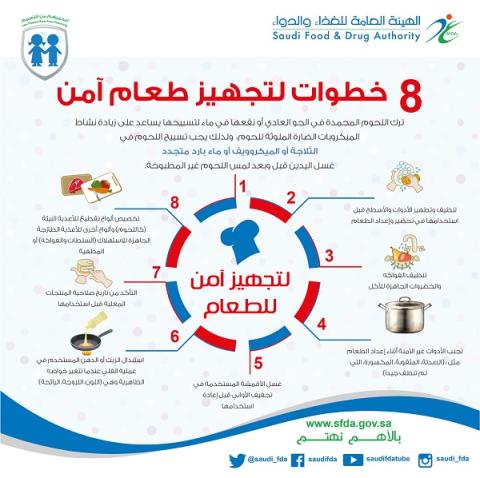In order for food processing to be safe and to ensure good cooking, you must follow these steps including washing hands, cleaning and disinfectioning tools and contaminated surfaces and fabrics used for cleaning before it is used again, with customizing plates for cutting raw food (such as meat) and other plates for the ready to eat food vegetables and fruits, and make sure that raw food won't contact ready to eat food, such as raw meat touching vegetables during the setup.
Also, you should consider defrosting frozen meat in the refrigerator or microwave or cold running water which helps to prevent stimulating microbes. Make sure of the validity date on canned products before using. Clean ready to eat fruits and vegetables, and do not use (rusty, broken, not well cleaned) tools because they contaminate food.
Cooking oil used in frying process is must be changed when its physical properties are changed (color/ increase the viscosity / odor). Make sure that cooking temperature shall not be less than 75°C and ensure that well-cooked food signs appear and not blood signs exist when cutting cooked meat or chicken or fish, with the importance of rotating liquid food periodically during cooking to ensure that temperature is the same on all sides. Observe the rate of air bubbles coming out from, because low rate of bubbles coming out from the food indicates that it is not cooked well.
Frozen Meat
Leaving frozen meat in ordinary air or soaked in water for defrosting, helps harmful microbes to activate in the meat, and therefore defrosting meat shall be in the refrigerator or microwave or running cold water. Always wash your hands before and after touching raw meat. Clean, disinfect and dry tools before each use. Avoid the use of one spoon several times while cooking to taste the food without cleaning it thoroughly after each use.
Ready-to-eat Fruits and Vegetables should be cleaned. Avoid the use of unsafe tools during preparing your food such as rusty or broken, or not cleaned tools, or using not closed sweets containers, with the need for replacement of oil used for frying when its physical properties (color / viscosity increase / odor) change.
It is important to make sure that no blood trace exists when cutting meat or chicken or fish after it is cooked. It is also importance to rotated liquid food periodically during the cooking to ensure that temperature is the same on all sides, Observe the rate of air bubbles coming out from, because low rate of bubbles coming out from the food indicates that it is not cooked well. Moreover, ensure when reheating the cooked foods that the temperature is not less than 70°. Use separate cutting board for fresh foods, raw foods, and ready-to-eat food.Wash plate- cleaning cloth and tea tissues and dry hem periodically before reusing them again. Dirty and damp cloth is a good place for reproduction of germs.
Steps for Keeping Food from Contamination
The steps for food preservation from contamination, include keeing chilled food at a temperature of 5 degrees Celsius in the refrigerator, and -18 ° C in the freezer, to minimize microbial growth, and arranging the food well in order to allow cold air to circulate sufficiently, and to keep ready- to -eat food on the top shelf of the refrigerator, and meat at the bottom, raw meat should be in containers or sealed plastic bags inside the refrigerator, to prevent leakage from the meat on other foodstuffs inside the refrigerator, and place fruits and vegetables in drawers, if any, or in the middle shelf if no drawers exist.
Hot foods must be kept at 65°C, or in the refrigerator directly at 4°C if not consumed within two hours from preparation, because if food is left for more than two hours it will help contamination. Observe that plastics materials not all considered all appropriate for containing food such as refrigerated and frozen meat and poultry and butter, because the use of unsuitable plastic material may lead to transfer of some chemical compounds into food.
Foods that have anti-decay properties can be kept for a long time, at room temperature 25 ° C because it had properties to resist contamination for a long time, (such as dried fruits, nuts, legumes, canned food).
Ready-to-eat Foods
Ready-to-eat foods can remain intact from contamination, by covering and keeping them in the fridge, and cleaning the refrigerator and freezer periodically from the remains of food and other pollutants to prevent microbial growth and reproduction.
When saving large quantities of cooked foods, it is preferred to divide them into small amounts or placed in containers not deeper than 5 cm, and hot food should be kept at 65°C or stored in the refrigerator immediately, if not consumed within two hours from preparation, at a temperature of 4°C.
